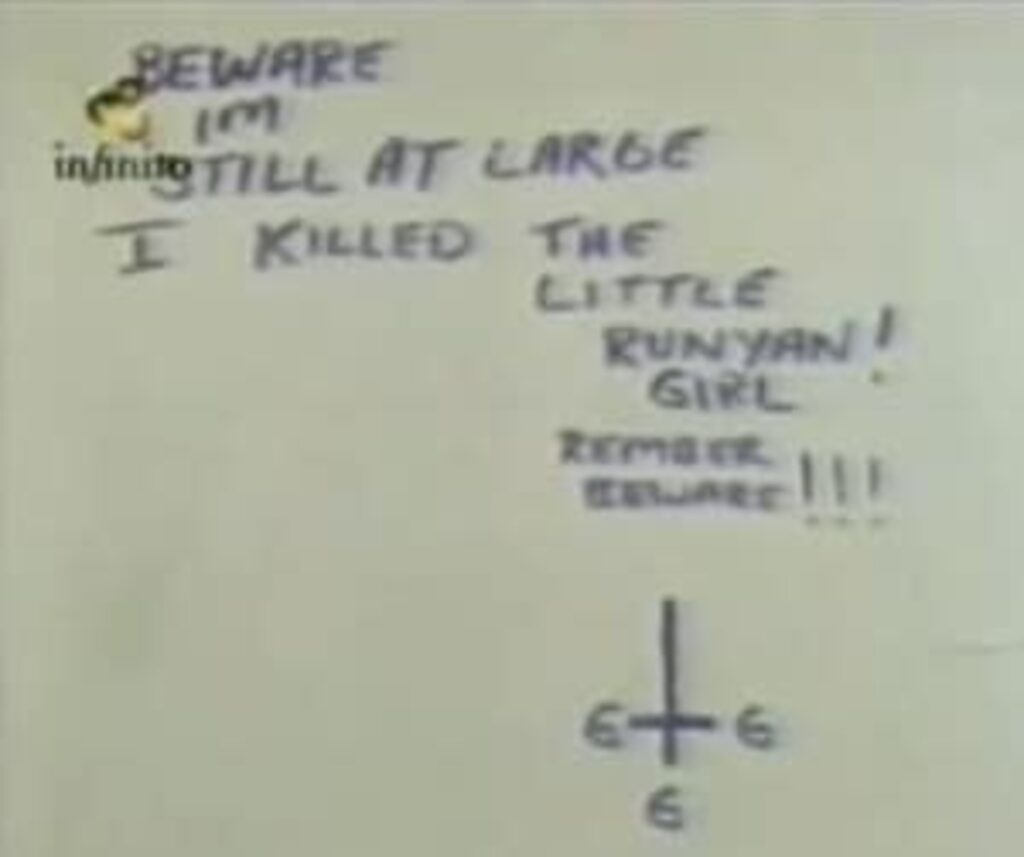SALT LAKE CITY, Utah — Rachael Runyan, 3, was abducted and violently murdered in 1982. Police never arrested her killer, but there is a suspect in the case.
The Runyan family resided on W 870 N in Sunset, directly south of Doxey Elementary School’s playground. During the summer of 1982, Jeff Runyan, 28, and his wife Elaine Runyan, 25, had installed a gate in their backyard to give them easy access to the playground and school. Elaine Runyan often took their three children — Justin, 5, Rachael, 3, and Nathan, 18 months old — there to play.
Around 1 p.m. on Aug. 26, 1982, Elaine Runyan made lunch and periodically watched the children play on the playground from the window, 15 feet away. She told KSL.com on the 40th anniversary of Rachael’s murder that she yelled for the kids to come home when she noticed they were across the field.
Justin told his mother that a man approached Rachael while playing and offered her bubble gum-flavored ice cream from a local supermarket. Justin warned his sister not to go. As Rachael walked away from the man, he grabbed her, threw her into his car, and sped away.
Rachael’s mother went to the supermarket, but nobody had seen her daughter and the man. She then called 911, and a massive investigation ensued. Elaine Runyan said her daughter wore a white playsuit with a green and blue flowered print, a blue ribbon in her hair, and gold studded earrings. She also wore brown leather shoes with bright yellow laces printed with the word “smile.”
Police learned the abductor had spoken with other children at the park for at least 15 minutes. The children described him as a black male around 6 feet tall with a slender build between 25-35 years of age, sporting an afro, and driving a blue 1973 Pinto Squire with wood-grain stripes on the side.
For 24 agonizing days, Rachael’s parents waited for word on their daughter’s whereabouts. Police thought maybe she was taken for ransom or sold into illegal adoption. There were few clues as to what happened to her.
The city of Sunset put up a $20,000 reward, and the Runyans contributed another $20,000 for information leading to the return or recovery of their daughter. Sunset residents plastered missing person flyers with Rachael’s picture and the original suspect composite sketch around the community. Truck drivers took some and passed them out at truck stops. Salespeople took them out of state, as did Utah residents visiting family elsewhere.
Meanwhile, the Runyans spoke with countless media outlets, including Good Morning America, and registered with Child Find, a non-profit organization created in 1980 to search for missing children.
Then on Sept. 19, 1982, an Ogden family out picnicking made a gruesome discovery. They had stopped their vehicle to stretch and enjoy the scenery. The children wandered off the road to a stream, where they found something floating in roughly a foot of water. They called for their father, who ran down and probed it with a stick, uncovering a small child’s body.
Morgan County Deputy Sheriff Bob Hastie received the call at 6:42 p.m. and immediately called the Davis County Crime Lab Department. He and Davis Crime Lab Sgt. Esplin then drove to the scene together, followed by Sunset police and the FBI.
The nude body was hogtied in a creek bed near Trapper’s Loop Road north of Mountain Green. The killer had attempted to conceal the body with shrubs. Authorities
Authorities searched the area surrounding the body and discovered a pair of underwear, later confirmed by the Runyans as Rachael’s. They transported the body to the State Medical Examiner’s office at 10:15 p.m. for identification purposes.
Hastie later told the Morgan County News, “It was a complete accident that the body was ever found. She was well hidden.” He also said the body was not “terribly decomposed,” but the water’s effects had removed several markings on the skin, making identification difficult and the cause of death impossible.
Several hours later, numerous tests and fingerprinting failed to identify the child, although investigators were confident it was Rachael. There were no dental records to compare to Rachael because she had yet to visit a dentist. Frustrated, they brought in Rachael’s parents, who identified her by a protruding, chipped tooth, and her gold earrings.
Police worked leads in the case and developed persons of interest but made no arrests, and the case went cold.
The Runyans became strong advocates for missing children and other crimes against children.
More than 30,000 Utah children were fingerprinted, their blood types were on file, and the parents were given identification packets in case a child went missing.
After Rachael’s murder, there were reports of abductions and kidnap of children. The murder of five young boys between 1979 and 1983 by serial killer Gary Bishop, aka Roger W. Downs, and Rachael’s murder angered numerous citizens.
Thousands of parents attended meetings on missing children. A group of concerned mothers came together to lobby the Utah legislature for stricter child abduction laws. More than 2,000 other Utah mothers took turns standing on street corners to ensure kids reached school safely.
A federal law passed in October 1982 gave parents of missing children access to a nationwide clearinghouse administered by the FBI, with the information sent to local law enforcement agencies all across the United States.
In early 1983, Elaine Runyan and other parents of missing children pleaded to pass a strict Utah child-kidnapping law. House Bill 209, sponsored by then-Representative Lyle Hillyard, required individuals convicted of kidnapping children to serve at least the minimum term imposed by a judge.
“Unsolved Mysteries” aired a segment on the murder in October 1989 with several interesting facts revealed. A few months before the airing, an unidentified woman told Salt Lake police that her brother had killed Rachael. During subsequent interviews as a paid informant, the woman told investigators he sexually defiled and tortured Rachael on videotape before murdering her in an Ogden home. However, she later admitted she lied, and police charged her with obstruction of justice. She served 40 days in the Weber County Jail in August and September 1989.
Jeff Runyan revealed that he had twice found mysterious black roses on Rachael’s grave.
“Unsolved Mysterieis” also revealed a message in black ink found by a security guard on the bathroom wall of an all-night laundry business seven miles from Sunset.

The sinister note, accompanied by the drawing of an inverted cross and the number 666, led some investigators to think Rachael’s murder might have been part of an occult ritual or cult activity. However, no evidence connected the writing to Rachael’s case, and it may have been a cruel hoax. A psychologist told police that if the letter was real, they needed to be ready because the killer would murder again.
In April 2002, Utah established the Rachael Alert system, later subsumed under the national Amber Alert, in the little’s girl’s honor. It was first used on June 5, 2002, when Brian David Mitchell and his wife, Wanda Barzee, kidnapped 14-year-old Elizabeth Smart from Salt Lake City. She was found nine months later, in March 2003.
In 2011, Pennsylvania State Police arrested Melvin Reeves, then 49, following an Amber alert when Reeves took his five-month-old son without permission after assaulting his girlfriend. Police were able to locate the man and his son, who was unharmed. Reeves has always been a suspect in Rachael’s murder.
Reeves strongly resembled the original composite sketch of the kidnapper. Furthermore, he resided in the Sunset area around the time of her murder, and a relative of his owned a car that closely matched the vehicle used in the abduction. However, a private investigator said that it was not a Pinto Squire and that only those cars had wooden panels in 1982. A Google search shows several 1970s cars with wooden side panels.
Police said Reeves remains the prime suspect. But in 2022, a woman said she believed her uncle had killed Rachael.
The anonymous woman told ABC 4: “We went to that elementary school with Rachael’s brother. My brother and he were about the same age. They were in the same class.”
Justin Runyan told ABC4 that he had tried to get the police to change the composite sketch. He now believes his sister’s killer was Hispanic and that he had a gap in his mustache.
“I wanted them to change some things but (they) wouldn’t,” said Justin Runyan in 2020. “It wasn’t until I was older and met with the FBI years later and they said it was because the other kid was ten and he knew better.”
The woman and her uncle are Hispanic. She said he drove a Pinto Squire in 1982.
“Yes I slept in that Pinto many times,” said the woman. “When you stayed at Grandpa and Grandma (name) you grabbed a sleeping bag and pillows and slept in the back of the car. It was fun.”
Her uncle was also a sex offender, and her family knew it.
“(Name) had hurt little girls before,” she said. (Name) had hurt one of the babysitters and did time in jail. That’s why when he was around, we were kind of banned from going over there,” she told ABC4.



